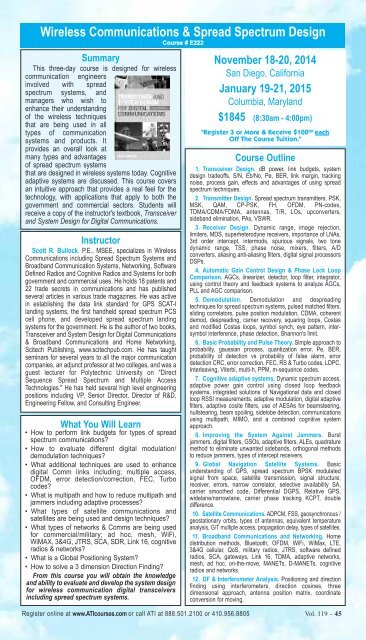Download - Applied Technology Institute
Download - Applied Technology Institute
Download - Applied Technology Institute
- No tags were found...
You also want an ePaper? Increase the reach of your titles
YUMPU automatically turns print PDFs into web optimized ePapers that Google loves.
Wireless Communications & Spread Spectrum DesignCourse # E222SummaryThis three-day course is designed for wirelesscommunication engineersinvolved with spreadspectrum systems, andmanagers who wish toenhance their understandingof the wireless techniquesthat are being used in alltypes of communicationsystems and products. Itprovides an overall look atmany types and advantagesof spread spectrum systemsthat are designed in wireless systems today. Cognitiveadaptive systems are discussed. This course coversan intuitive approach that provides a real feel for thetechnology, with applications that apply to both thegovernment and commercial sectors. Students willreceive a copy of the instructor's textbook, Transceiverand System Design for Digital Communications.InstructorScott R. Bullock, P.E., MSEE, specializes in WirelessCommunications including Spread Spectrum Systems andBroadband Communication Systems, Networking, SoftwareDefined Radios and Cognitive Radios and Systems for bothgovernment and commercial uses. He holds 18 patents and22 trade secrets in communications and has publishedseveral articles in various trade magazines. He was activein establishing the data link standard for GPS SCAT-Ilanding systems, the first handheld spread spectrum PCScell phone, and developed spread spectrum landingsystems for the government. He is the author of two books,Transceiver and System Design for Digital Communications& Broadband Communications and Home Networking,Scitech Publishing, www.scitechpub.com. He has taughtseminars for several years to all the major communicationcompanies, an adjunct professor at two colleges, and was aguest lecturer for Polytechnic University on "DirectSequence Spread Spectrum and Multiple AccessTechnologies." He has held several high level engineeringpositions including VP, Senior Director, Director of R&D,Engineering Fellow, and Consulting Engineer.What You Will Learn• How to perform link budgets for types of spreadspectrum communications?• How to evaluate different digital modulation/demodulation techniques?• What additional techniques are used to enhancedigital Comm links including; multiple access,OFDM, error detection/correction, FEC, Turbocodes?• What is multipath and how to reduce multipath andjammers including adaptive processes?• What types of satellite communications andsatellites are being used and design techniques?• What types of networks & Comms are being usedfor commercial/military; ad hoc, mesh, WiFi,WiMAX, 3&4G, JTRS, SCA, SDR, Link 16, cognitiveradios & networks?• What is a Global Positioning System?• How to solve a 3 dimension Direction Finding?From this course you will obtain the knowledgeand ability to evaluate and develop the system designfor wireless communication digital transceiversincluding spread spectrum systems.November 18-20, 2014San Diego, CaliforniaJanuary 19-21, 2015Columbia, Maryland$1845 (8:30am - 4:00pm)"Register 3 or More & Receive $100 00 eachOff The Course Tuition."Course Outline1. Transceiver Design. dB power, link budgets, systemdesign tradeoffs, S/N, Eb/No, Pe, BER, link margin, trackingnoise, process gain, effects and advantages of using spreadspectrum techniques.2. Transmitter Design. Spread spectrum transmitters, PSK,MSK, QAM, CP-PSK, FH, OFDM, PN-codes,TDMA/CDMA/FDMA, antennas, T/R, LOs, upconverters,sideband elimination, PAs, VSWR.3. Receiver Design. Dynamic range, image rejection,limiters, MDS, superheterodyne receivers, importance of LNAs,3rd order intercept, intermods, spurious signals, two tonedynamic range, TSS, phase noise, mixers, filters, A/Dconverters, aliasing anti-aliasing filters, digital signal processorsDSPs.4. Automatic Gain Control Design & Phase Lock LoopComparison. AGCs, linearizer, detector, loop filter, integrator,using control theory and feedback systems to analyze AGCs,PLL and AGC comparison.5. Demodulation. Demodulation and despreadingtechniques for spread spectrum systems, pulsed matched filters,sliding correlators, pulse position modulation, CDMA, coherentdemod, despreading, carrier recovery, squaring loops, Costasand modified Costas loops, symbol synch, eye pattern, intersymbolinterference, phase detection, Shannon's limit.6. Basic Probability and Pulse Theory. Simple approach toprobability, gaussian process, quantization error, Pe, BER,probability of detection vs probability of false alarm, errordetection CRC, error correction, FEC, RS & Turbo codes, LDPC,Interleaving, Viterbi, multi-h, PPM, m-sequence codes.7. Cognitive adaptive systems. Dynamic spectrum access,adaptive power gain control using closed loop feedbacksystems, integrated solutions of Navigational data and closedloop RSSI measurements, adaptive modulation, digital adaptivefilters, adaptive cosite filters, use of AESAs for beamsteering,nullstearing, beam spoiling, sidelobe detection, communicationsusing multipath, MIMO, and a combined cognitive systemapproach.8. Improving the System Against Jammers. Burstjammers, digital filters, GSOs, adaptive filters, ALEs, quadraturemethod to eliminate unwanted sidebands, orthogonal methodsto reduce jammers, types of intercept receivers.9. Global Navigation Satellite Systems. Basicunderstanding of GPS, spread spectrum BPSK modulatedsignal from space, satellite transmission, signal structure,receiver, errors, narrow correlator, selective availability SA,carrier smoothed code, Differential DGPS, Relative GPS,widelane/narrowlane, carrier phase tracking KCPT, doubledifference.10. Satellite Communications. ADPCM, FSS, geosynchronous /geostationary orbits, types of antennas, equivalent temperatureanalysis, G/T multiple access, propagation delay, types of satellites.11. Broadband Communications and Networking. Homedistribution methods, Bluetooth, OFDM, WiFi, WiMax, LTE,3&4G cellular, QoS, military radios, JTRS, software definedradios, SCA, gateways, Link 16, TDMA, adaptive networks,mesh, ad hoc, on-the-move, MANETs, D-MANETs, cognitiveradios and networks.12. DF & Interferometer Analysis. Positioning and directionfinding using interferometers, direction cosines, threedimensional approach, antenna position matrix, coordinateconversion for moving.Register online at www.ATIcourses.com or call ATI at 888.501.2100 or 410.956.8805 Vol. 119 – 45
















